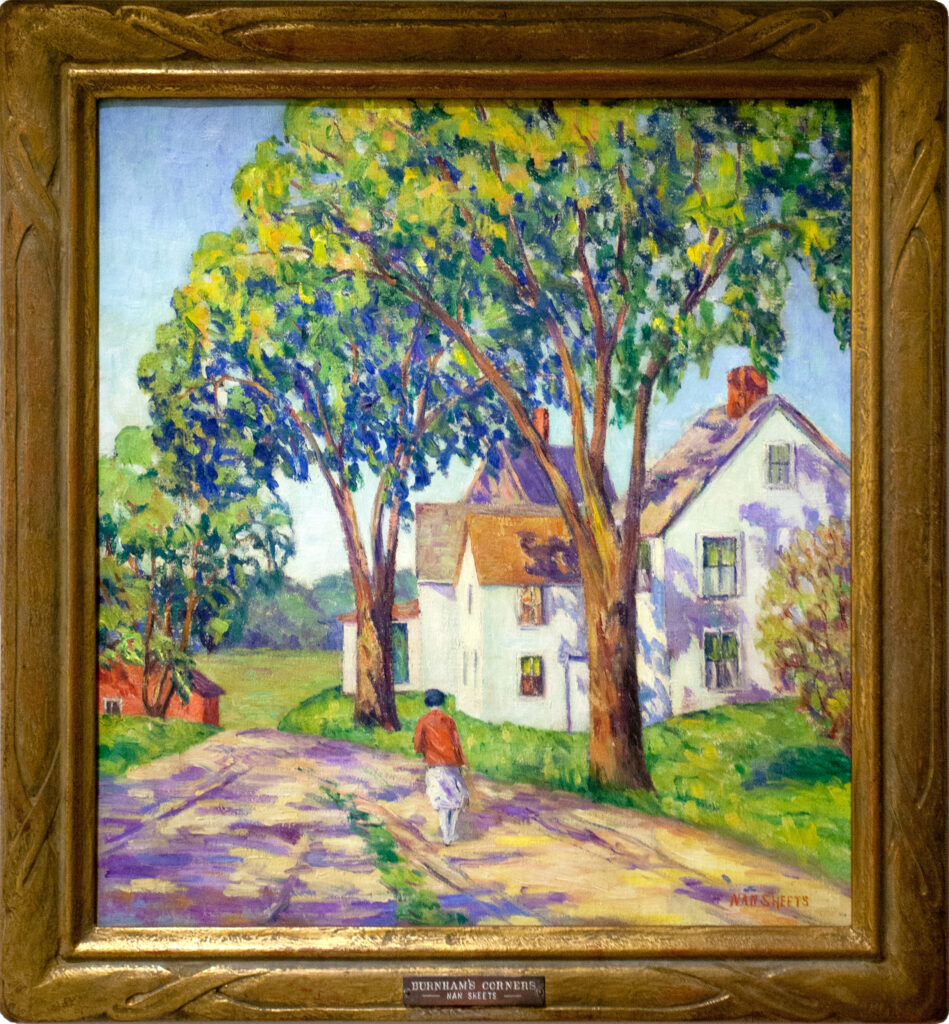Artist: Nan Sheets
As a child, Nannine Jane Quick’s mother would take her to the Art Institute of Chicago. “I can remember distinctly standing in the Art Institute one day, and thinking what a wonderful thing it was, wonderful building, wonderful paintings. The whole atmosphere thrilled me. And what a wonderful thing it would be to be head of an institution like that.”
Instead of pursuing her art dreams immediately, Sheets took a more practical route, graduating with a pharmacy degree from Valparaiso College in Indiana in 1905. She practiced as a pharmacist for a few years before marrying physician Fred Sheets in 1910. The couple moved to Bartlesville and then settled in Oklahoma City in 1916.
In 1919, Sheets began taking summer classes with John F. Carlson at the Broadmoor Academy of Fine Arts in Colorado Springs, Colorado. She exhibited her works in the Dallas Museum of Art, the Witte Museum in San Antonio and the Fort Worth Museum. In 1923, she became the first Oklahoman included in Who’s Who in American Art. That year she was also invited to join the National Association of Women Painters and Sculptors, based in New York. In 1940, her works were exhibited at the New York World’s Fair. Each summer, she traveled, studied and painted across the United States and Europe. Burnham’s Corners was painted during a trip to Potsdam, New York.
But Sheets’ contribution to the art world reaches far beyond the canvases she painted. In 1935, she got a phone call from Thomas Parker, assistant director of the Federal Art Project, to discuss the possibility of opening up an art institute in Oklahoma City. Through the support of Oklahoma City Chamber of Commerce Manager Stanley Draper and businessman Dudley Callahan, Sheets oversaw the opening of the WPA Experimental Gallery in December of 1935 – Oklahoma City’s first public art museum. As the project grew, Sheets was named director of the WPA Art Program in Oklahoma, one of only a few women in the nation to hold such a post.
In her capacity as director, she commissioned artworks in dozens of public buildings across Oklahoma, including murals for the State Historical Society, which is now the Oklahoma Judicial Center. See these murals and biography of their artists on page 149. In an oral history interview conducted in 1964, Sheets recalled advising Monroe Tsatoke to use oil paints and assisted him in purchasing supplies.
She continued as director until the WPA program was disbanded by the federal government in 1942. A lack of government funding wouldn’t deter Sheets from keeping an art museum open in Oklahoma City. In addition to managing the museum, she swept the floors, organized exhibitions and spearheaded fundraising. The Oklahoma Art Center hosted as many as thirty exhibitions a year. Sheets wrote articles about art for the Daily Oklahoman and an art column for Oklahoma Woman magazine. In 1945, with the help of Eleanor Kirkpatrick, Sheets organized the first Beaux Arts Ball. The success of the event led to the Oklahoma Art Center’s incorporation later that year. This organization eventually became the current Oklahoma City Museum of Art. She retired as director in 1965.
In the 1950s, Sheets learned that the Historical Society murals she commissioned were in danger. She convinced building supervisors to keep the murals and arranged for an artist to restore the paintings. See the complete story on page 152. Her actions that day saved an Oklahoma treasure, preserving the foundation of what would become the Oklahoma Judicial Center’s art collection.
Sheets’ work is included in the collections of the Vanderpoel Museum of American Art in Chicago, the Elizabet Ney Museum in Austin, the Kansas City Art Institute, the Dallas Museum of Art and the Delgado Museum in New Orleans. Her home is now the site of the JRB Gallery in Oklahoma City. Burnham’s Corners is on permanent loan from the Oklahoma Historical Society.
